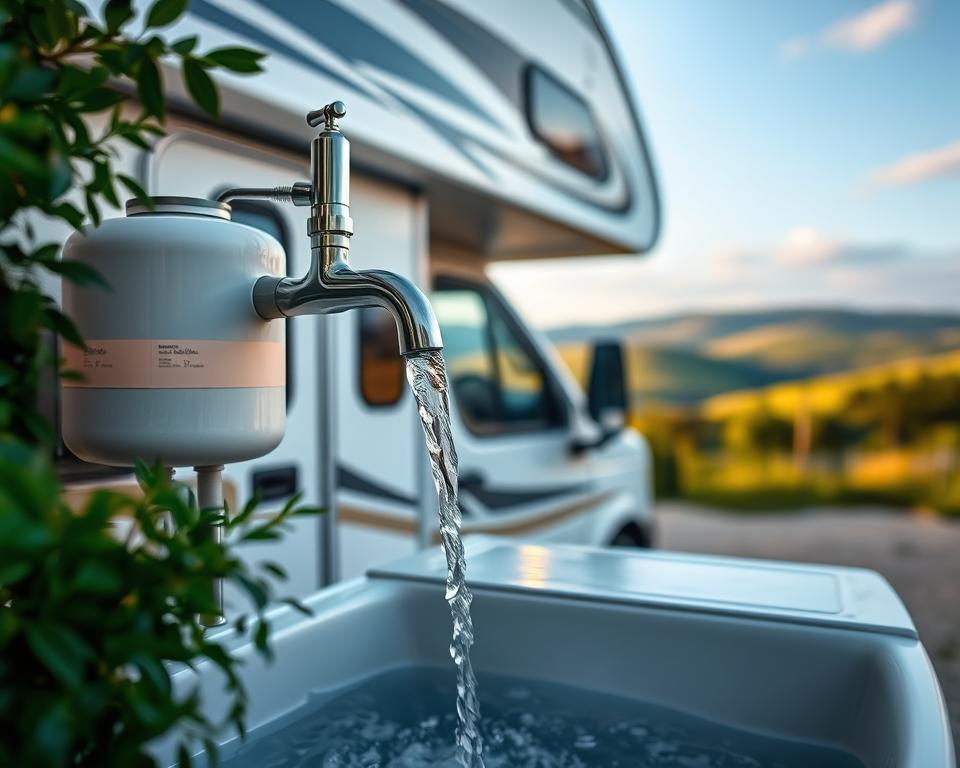Boost Your RV’s Plumbing Performance with a Pressure Tank
Ever pondered the impact of an RV pressure tank on your camping trips? While journeying, your RV’s plumbing system becomes vital for everyday tasks such as bathing and dishwashing. Optimizing this system ensures a steady and reliable water flow, vital on the road. Let’s dive into how an RV pressure tank can optimize your onboard water system – RV black water tank pump, improving comfort during your adventures.
Key Takeaways
- Pressure tanks improve mobile water delivery.
- Reliable water systems are crucial for everyday RV tasks.
- Fine-tuning plumbing enhances your outdoor stay.
- Pressure vessels ensure even delivery.
- Better flow aids all plumbing operations.
Why a Dependable RV Water System Matters
Consistent plumbing is key to enjoyable RV trips. It ensures daily tasks like showering, washing dishes, and using the toilet are trouble-free. Challenges such as low water pressure can disrupt these activities, highlighting the necessity of proper water flow in your RV.
Low water pressure can stem from multiple problems. Leaks, clogged filters, or insufficient water supply are common causes. Not only do these problems disrupt convenience, but they can also lead to bigger problems without timely intervention. Thus, consistent maintenance is crucial for a well-functioning RV plumbing system.
Important aspects of maintaining a robust RV water system include:
- Inspecting all fittings and lines for drips
- Maintaining clear filter elements
- Installing a regulator to protect your plumbing
Keeping these practices top of mind empowers RV owners to enhance their water flow. It makes the camping experience more pleasant.

Role of the Pressure Tank in Your RV’s Water System
An RV pressure tank plays a crucial role in a recreational vehicle’s water system. It ensures water pressure remains stable and consistent. This component stores and buffers water, making it available even when demand peaks. It avoids the inconvenience caused by pressure drops.
The design of an RV water pressure tank often incorporates a bladder or diaphragm. This feature separates water from air, allowing for swift pressurization. Understanding how a camper pressure tank works empowers RV owners to take control of their water system. A quality motorhome pressure tank enhances water delivery’s reliability and efficiency.
Benefits of Pressure Tanks for Flow
An RV pressure tank plays a crucial role by providing consistent water flow. It avoids flow drop-outs under simultaneous use. When faucets, showers, and toilets operate together, a pressure tank keeps the supply steady.
This tank takes the load off the pump system, leading to higher efficiency. It stores pressurized air, pushing water through the system. This results in the water pump runs fewer cycles. The result? Lower power draw and an extended water pump life.
Thanks to these tanks, RV owners enjoy dependable water flow, enhancing their experience. No more weak streams or pauses. Understanding its operation helps you sidestep flow issues.
| Feature | Advantage |
|---|---|
| Uniform Flow | Provides reliable delivery for daily tasks |
| Less Pump Cycling | Decreases wear on your pump |
| Quick Water Delivery | Speeds up usage at any tap |
| Simple Setup | Simplifies upgrades to the RV water system |
Benefits of Installing a Recreational Vehicle Pressure Tank
Adding a pressure vessel delivers multiple benefits. It leads to consistent water pressure, enhancing showering, cooking, and cleaning experiences. The absence of sudden water flow drops allows for fluid operation.
It also eases strain on the pump. By maintaining even pressure, the tank extends the pump’s lifespan and reduces service calls. This results in noticeable maintenance cost savings and less inconvenience over time.
Better water usage is another benefit. It helps avoid issues such as drips and bursts. These tanks boost plumbing system reliability, ensuring hassle-free trips. With careful installation and regular upkeep, they bring assurance and comfort.
Picking the Perfect Camper Pressure Vessel
Choosing the correct RV pressure tank requires thought on many aspects to match your RV water system’s needs. Start by evaluating size. RV pressure tanks vary in size; knowing how much water you use will help pick the right one.
The tank’s material significantly impacts durability. Tanks constructed from stainless steel or polyethylene last longer and resist corrosion. It’s crucial to select a tank that handles road vibrations and varying climates.
Diaphragm tanks stand out when considering options. They efficiently maintain pressure and reduce water hammer. Checking model specifications ensures compatibility with your system.
Getting advice from RV experts is beneficial. They ensure the tank works well with your RV’s plumbing, so you get a setup that runs flawlessly.
Step-by-Step Pressure Tank Installation
Fitting a tank transforms your plumbing performance. It’s important to pay close attention and know RV plumbing basics. Start by picking the right spot for future maintenance.
Next, fasten the supply and return lines tightly. Make sure everything is leak-free. A key part is verifying the air pressure inside the bladder, which is essential for optimal performance.
When unsure, hire a qualified technician, like those at All in Sanitation. Their expertise guarantees proper fitting, boosting your system’s flow and reliability. Always follow the instructions for long-term performance.
| Installation Steps | Notes |
|---|---|
| Choose Position | Pick a convenient spot with easy access |
| Connecting Pipes | Secure inlet and outlet to avoid leaks |
| Checking Air Pressure | Use a pressure gauge |
| Adhere to Guidelines | Don’t skip any steps |
| Seek Professional Help | Ensure proper setup |
Pressure Tank Maintenance Tips
To maximize lifespan, maintain regularly. Regular checks for leaks are essential to prevent water waste and ensure air pressure settings are correct. Additionally, check and clean filters regularly.
A clear filter keeps water moving freely. An annual inspection is recommended to assess the tank’s performance and the associated plumbing. Documenting maintenance makes tracking easier.
Well-maintained tanks deliver steady flow, making every trip more enjoyable.
| Task | Frequency | Description |
|---|---|---|
| Leak Inspection | Every Month | Inspect connections and seams for water seepage |
| Precharge Inspection | Every Month | Use a gauge |
| Water Filter Cleaning | Every 3 Months | Keep pathways clear |
| Yearly Service | Yearly | Conduct a full system inspection |
Advanced Pressure-Enhancing Techniques
Implementing strategic practices can significantly improve RV water pressure. A water pressure regulator is vital, as it maintains steady flow and prevents damage from pressure spikes.
Improving pressure also involves limiting simultaneous use of water fixtures. Prioritize needs, for example, shower or sink at different times.
Shortening shower times is key for maintaining strong pressure. This conserves water and stabilizes pressure, improving overall performance.
Keeping the water filter clean is crucial. A clogged filter restricts flow and undermines pressure. Regular maintenance ensures optimal performance.
Regular checks of the water heater bypass valve are essential. A working bypass enhances performance, boosting the camper’s water system.
| Tip | What to Do | Impact on Water Pressure |
|---|---|---|
| Water Pressure Regulator | Maintain steady water pressure | Protects plumbing, ensures uniform flow |
| Stagger Usage | Prioritize one at a time | Reduces system overload |
| Quick Rinses | Reduce time spent in the shower | Stops pressure from dropping |
| Clean Water Filter | Ensure the filter is free from debris | Prevents clogs |
| Valve Inspection | Regularly inspect for proper operation | Supports smooth flow |
To Summarize
Recognizing the significance of the RV pressure tank is vital for enhancing your RV water system. It ensures a reliable supply and solid pressure, improving your road experiences. This dependability turns camping into stress-free outings.
Proper setup and upkeep maximize gains. Routine checks prevent flow hiccups. Implementing water pressure strategies further ensures a flawless system.
Applying these tips guarantees worry-free water use. You can relish your time outdoors without concerns over water quality or supply. Camp confidently on every trip!

